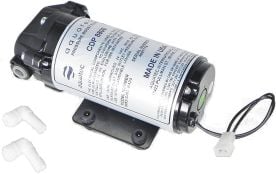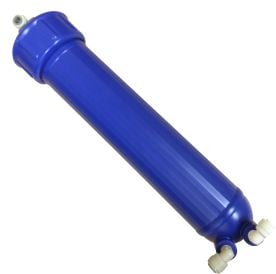
Understanding Reverse Osmosis Systems
The U.S. Centers for Disease Control and Prevention (CDC) defines Reverse Osmosis (RO) systems as “Reverse Osmosis Systems use a process that reverses the flow of water in a natural process of osmosis so that water passes from a more concentrated solution to a more dilute solution through a semi-permeable membrane. Pre- and post-filters are often incorporated along with the reverse osmosis membrane itself.”
Reverse Osmosis (RO) is a water purification and filtration process that uses a semi-permeable membrane to filter out the impurities and contaminants from source water. According to the United States Environmental Protection Agency (EPA), “RO is the process by which pressure forces water through a semi-permeable membrane, creating a stream of treated water, called ‘permeate,’ and a stream of reject water called ‘concentrate’ or ‘brine.’”
The semi-permeable membrane of RO usually has a pore size of around 0.0001 microns to filter out harmful impurities like sodium, chloride, copper, chromium, lead, dirt particles, TDS, and more. Additionally, it may reduce contaminants, including arsenic, fluoride, calcium, radium, sulfate, magnesium, potassium, nitrate, and phosphorous, to dispense pure water.
Common Causes of Low Water Pressure
Low water pressure from a Reverse Osmosis (RO) system is a common concern for users. It takes more time to fill even a glass. As discussed here, there are many causes of low water pressure from RO systems.
Low pressure from water source or supplier
The temporary low water pressure from the local water utility supplying company could be responsible for the slow water flow rate from RO systems. If the water pressure of other taps and facets of the household is also low, then it could be a temporary issue. They might be flowing water at a low rate; wait for it to resume regular pressure. If other taps and faucets have regular pressure, then reach out to the RO service provider for the concern.
Kink in water supply line
A kink in the water supply line connected to the RO system could be responsible for low pressure. Ensure there is no kink or pinch in the supply line for regular pressure from the reverse osmosis system.
Clogged RO filter
Regular maintenance of the Reverse Osmosis (RO) system gives pure and healthy filtered water at the desired flow. However, due to impurities and contaminants in the source water, the filters can get clogged, resulting in low pressure. Therefore, it is important to always follow routine maintenance and replace the water filters as scheduled.
Clogged RO Membrane
The RO membranes are essential components of Reverse Osmosis purification. They require regular maintenance and replacement. Follow the scheduled replacement routine for RO membranes, as a clogged one will result in low water pressure.
Depressurized RO Tank
If the water dispensed from the RO system is about one cup at a normal flow rate and then falls down to a trickle, it’s a sign of either tank bladder rupture or depressurization. Sadly, the bladder of the Reverse Osmosis (RO) system cannot be replaced, so the entire storage tank needs to be replaced in the case of a rupture. Firstly though check the schrader air valve near the bottom of the tank. If upon pressing it to release the air, instead, water comes out, then the bladder is ruptured and the tank should be released. However, if no water comes out, then proceed to add air to the tank with a bike or ball pump. If the air you just added, burps out of the RO faucet, then the bladder is ruptured. However if it holds the air, and then water flows from the RO faucet, then continue adding air until the tank is empty of water. Then adjust the pressure to the manufacturer's recommended psi setting, usually 7.5 psi with Home Master 3.2 gallon tanks. Here’s the Home Master Tank Repressurization video.
Tips to boost RO pressure
Low water pressure from Reverse Osmosis (RO) systems is a concern for users. If the Reverse Osmosis system is dispensing water at a low rate, first check out the above reasons. If the problem persists, then use these tips.
- Use a permeate pump to regulate water flow in the Reverse Osmosis system. A Permeate pump is not electric and instead utilizes the energy of drain water flow to increase the water flow to, and pressure in the storage tank. You can also install the Reverse Osmosis (RO) system that comes with a built-in Permeate Pump or add one to an existing RO system.
- Use an electric reverse osmosis booster pump to ensure the system receives consistent, strong water pressure. Ensure that any booster pump installation includes a tank pressure switch so that the pump switches off at the correct pressure for the tank.
- Increase the tank capacity by adding more storage tanks or replace the existing tank with a bigger one to get more usable capacity and better water flow.
- Increase the membrane capacity by a higher capacity membrane with a matching flow restrictor.
- Replace smaller tubing, outlets, and fittings with bigger ones to get higher pressure.
The above tips provide a holistic solution to boost RO pressure; however, if the problem persists, then get in touch with an RO expert.
Regular Maintenance for Optimal Pressure
A reverse osmosis (RO) system requires regular maintenance to achieve optimal pressure and consistent water flow. Here, a regular maintenance routine to get optimal pressure from the RO system.
- Replace the sediment pre-filter every 6 to 12 months or sooner if it gets clogged
- Replace the RO membrane every 2-5 years
- Check and maintain RO storage tank pressure
- Most RO service can be done DIY, or reach out the manufacturer’s customer service team.
Conclusion
A reverse osmosis (RO) system is an advanced purification and filtration system that dispenses pure, healthy, and clean water directly from the tap. The RO system helps remove most impurities and contaminants like sodium, chloride, copper, chromium, lead, arsenic, fluoride, calcium, radium, sulfate, magnesium, potassium, nitrate, phosphorous, dirt particles, TDS, and more. However, there are events when there is low pressure or water flow rate inconsistency. In such cases, follow the tips given above to find the reasons and get it fixed. Also, to avoid this situation in the future, follow the given routine maintenance and ensure the water dispensing rate is optimal. If the low-pressure problem persists, then a permeate pump or reverse osmosis booster pump should be used to increase the water pressure.





